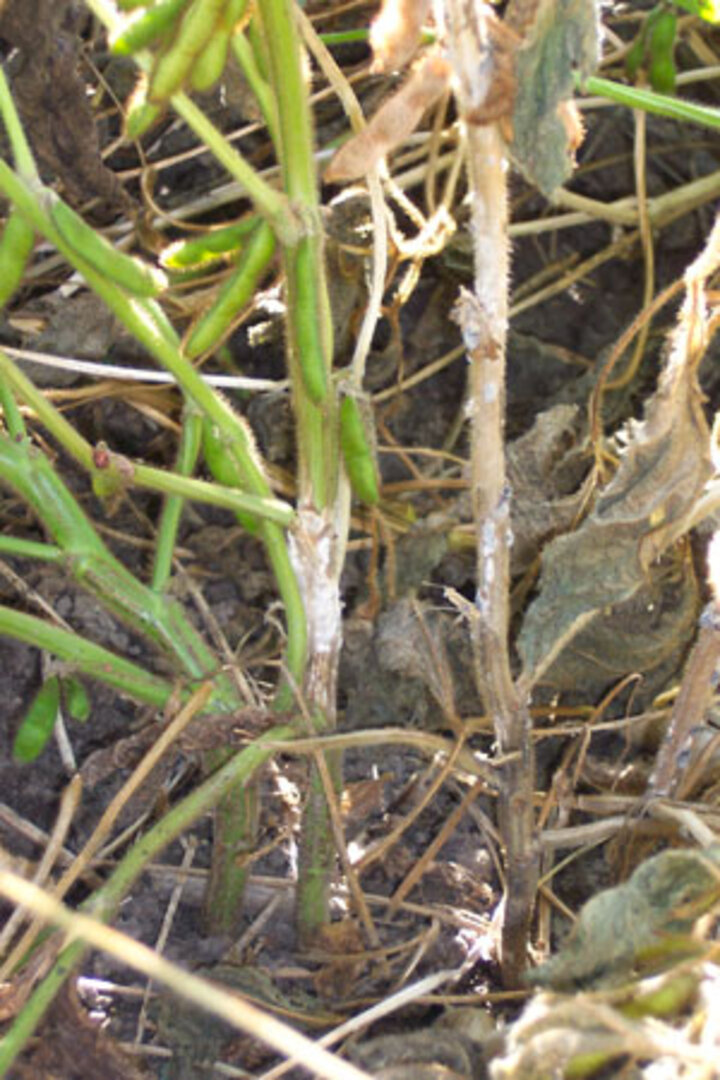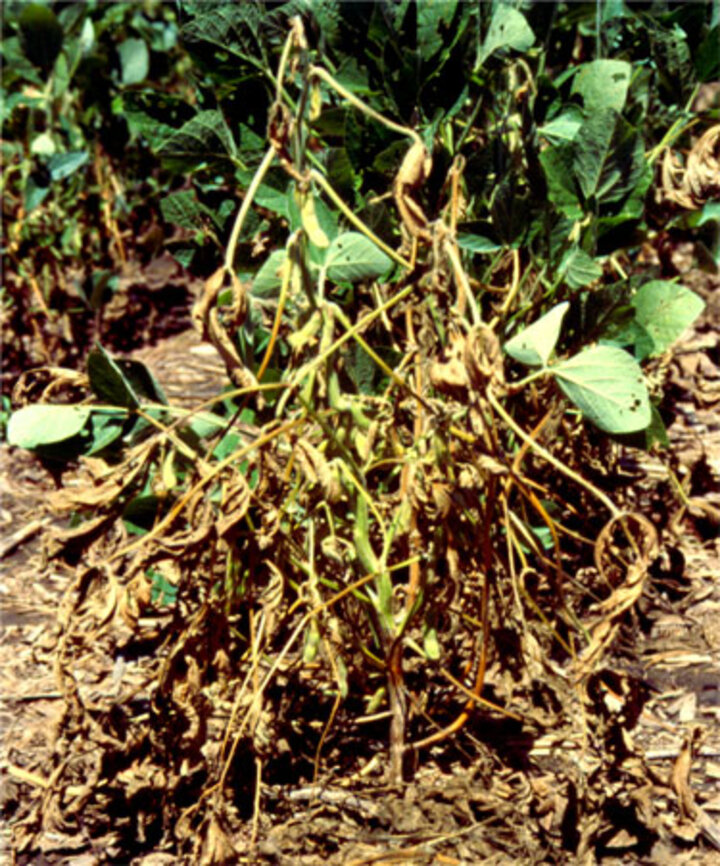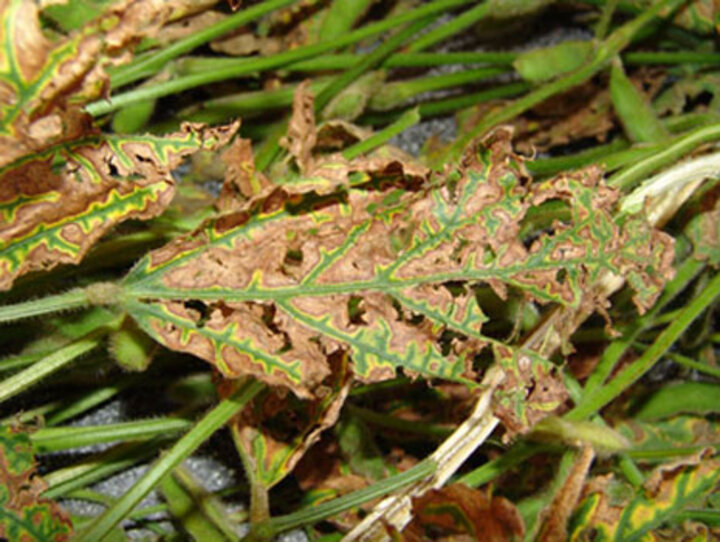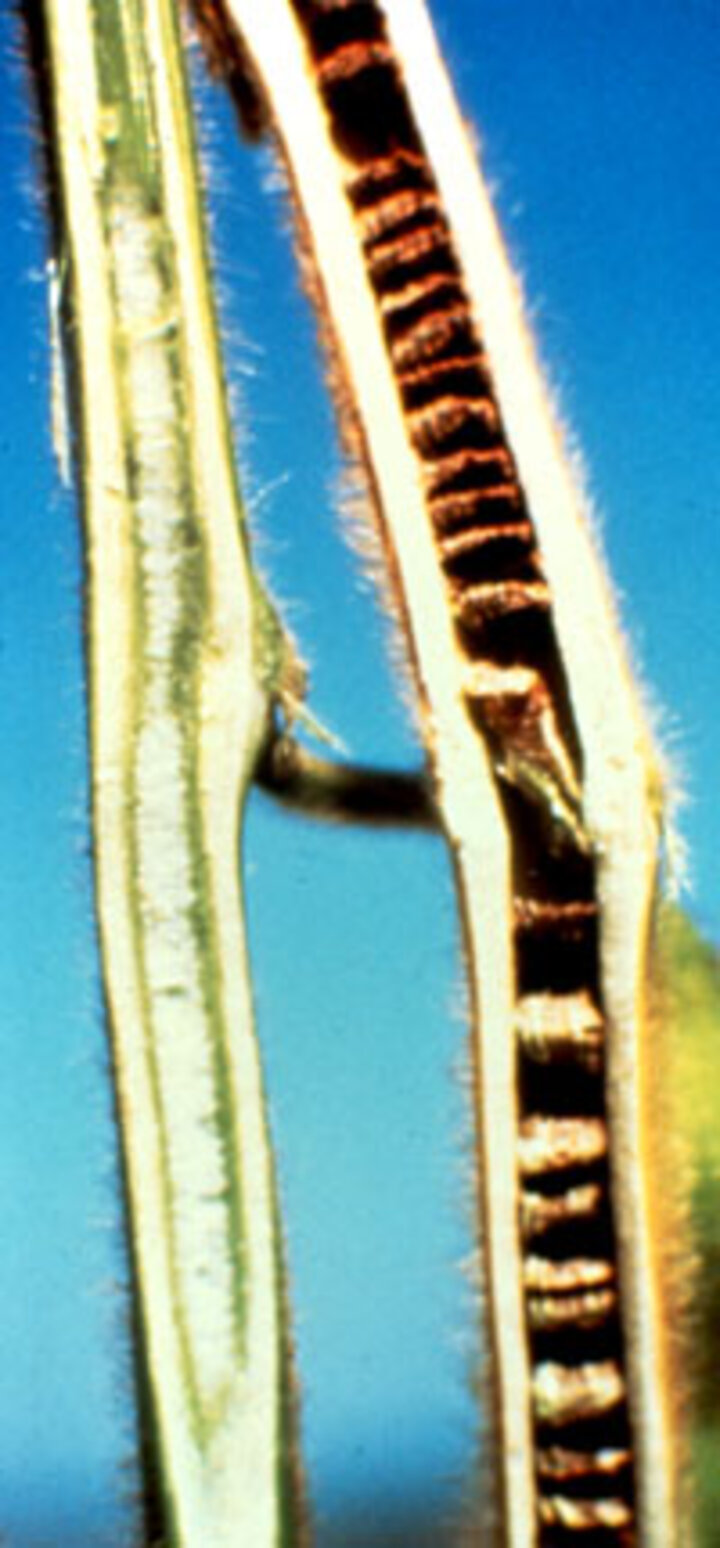Also see this Market Journal segment where the author discusses late season soybean diseases.


Over the past few weeks we have seen several stem and root rots continuing to develop. As most of these will be managed primarily with variety selection, it is critical to get them identified correctly. Once again this year we are seeing white mold in several fields in northern Nebraska. We also continue to see Brown Stem Rot, Phytophthora Root and Stem Rot, and Sudden Death Syndrome. We also had a field in southeast Nebraska with Stem Canker.
Sclerotinia Stem Rot
White mold or Sclerotinia Stem Rot is a disease that starts earlier in the season during flowering. The actual infection occurs on the senescing flower when the fungus uses it as a food source. All infections in soybean will therefore, typically start at a node. You can even tell when the infection occurred based on how high up the plant the stem lesions and fungal growth occur. Cool, wet conditions during flowering were favorable for infection and cool temperatures the last couple weeks were very favorable for more fungal growth.
Symptoms at this point in soybean development will appear as individual or small pockets of dead or dying plants. Upon close inspection you will see a white cottony fungal growth on the stems which may include dark black bodies (sclerotia) of the fungus. If it is drier and plants are dead, the stems will be very light (bleached) in color. When dead stems are split, you will often see the sclerotia of the fungus inside. Keep in mind that the disease will not spread very much if temperatures are in the 90s. The optimum temperature for growth of the fungus is 75°F.
Phytophthora Root and Stem Rot
Throughout the season we have seen Phytophthora Root and Stem Rot. Symptoms associated with Phytophthora sojae infections include seed rots, pre- and post-emergence damping off of seedlings, and stem rot of plants at various growth stages. The stem rot phase is easily identified by the dark brown color on the exterior surface of the stem and lower branches. Discoloration of the stem extends from below the soil to 6 inches or more above the soil line. The taproot turns dark brown and the entire root system may be rotted. Leaves on older infected plants become chlorotic between the veins followed by general wilting and death. Leaves will remain attached.
The author discusses management of phytophthora in this YouTube video.
Sudden Death Syndrome
 Figure 3. Sudden Death Syndrome
Figure 3. Sudden Death Syndrome

This year's cool, wet soil conditions at planting were favorable for early infection with Sudden Death Syndrome (SDS). The first signs of SDS appear as scattered yellow or white spots on the leaves in the upper portion of the canopy. In the intermediate stage, these spots eventually coalesce to form brown streaks between the veins (interveinal necrosis). On these leaves only the midvein and major lateral veins remain green. As the disease reaches the more advanced stages, premature defoliation occurs with petioles (leaf stems) remaining on the plant.
The progression from early symptom to defoliation will occur rapidly (less than 14 days in most cases). Symptoms of SDS can be confused with brown stem rot symptoms. To differentiate the two, split the stems of infected plants and check for discoloration. If the pith (center stem) is discolored, this is a symptom of brown stem rot. Stem discoloration will be confined to the outer stem layers (vascular tissue) with SDS and can extend up the stem of infected plants. Leaves will typically defoliate in the later stages and the leaf stem (petiole) will remain attached.

Brown Stem Rot
Brown Stem Rot (BSR) is a disease that can look a lot like SDS. Infected plants may not show visible symptoms other than premature death, which may be confused with early maturity or dry weather. Brown stem rot can produce both foliar and/or stem symptoms. Split stems of infected plants reveal internal browning of the pith and vascular tissue. Pith discoloration starts at the base of the stem and moves upward to the nodes and progresses into the internodal tissues during the growing season. Later in the season, infected plants may wilt and show external browning on the lower part of the stem. Severely diseased plants may lodge.
Leaf symptoms may resemble high temperature "scorch" or drought stress. Leaves on infected plants may develop interveinal chlorotic (yellowish) blotches. Tissue between the veins dies and turns brown, whereas tissue adjacent to veins remains green and is the last to die. This foliar symptom can be confused with sudden death syndrome. Eventually all leaves will curl and die and will remain attached to the leaf stem (petiole). Foliar symptoms will not develop if air temperatures are high (above 85oF) during the R3-R4 growth stages. Field distribution will typically be patches or packets of plants being affected.
Management
The best action at this time is to make sure you identify these and other problems correctly so that you can use resistance to manage the problem in the future. As with any disease, correct diagnose is critical to proper management. If you are uncertain of the cause of damage in your field, I encourage you to have it identified at the Plant and Pest Diagnostic Clinic.
More information on these and other soybean diseases can be found in the Disease Management of Soybeans section in CropWatch Plant Diseases.
Loren Giesler
Extension Plant Pathologist
